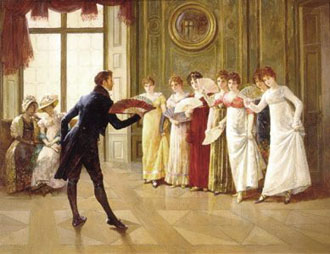 Lovers of Regency novels and series, such as Pride and Prejudice and Wives and Daughters, will know that going to a dance was a popular form of entertainment in this era. Dances ranged from lavish balls at Almacks or at great country houses to impromptu dances attended by family and friends after dinner. Dances provided an opportunity for young men and women to meet suitable husbands and wives.
Lovers of Regency novels and series, such as Pride and Prejudice and Wives and Daughters, will know that going to a dance was a popular form of entertainment in this era. Dances ranged from lavish balls at Almacks or at great country houses to impromptu dances attended by family and friends after dinner. Dances provided an opportunity for young men and women to meet suitable husbands and wives.
Most towns 'with pretensions to fashion and a sizeable middle-class population'1 had their own Assembly Rooms in which balls were held. The most famous of these, is of course, Bath's. Here there were two sets of rooms, in the Upper and Lower sections of the city.
These affairs were not nearly as elegant and stylish as balls held by the country gentry at which professional musicians were engaged and abundant suppers were provided.
Dances in the Regency era were elaborate, involving intricate steps and quite difficult to learn. Most of the dances were English Country Dances - these were somewhat similar to Scottish Country Dancing - all the dancers faced each other in a long line, and the movements involved elaborate patterns.
Two dances were with the same partner and usually lasted for half an hour, so it would not have been pleasant to dance these with someone that you didn't like!
The English Country Dance dates from about the 16th century, and were popular even then amongst the middle classes. At court these dances were used to complete the evening.
By the beginning of the 18th century dances such as the Branles, Corantos and Gavottes had become 'ever more complex, stilted and affected'2, so European dances were increasingly re-placed by English Country Dances.
Although many thought that the contredance was originally French, these dances were, in fact, exported from Britain to France, in spite of the name, which was used to describe the English Country Dance in longways form.
Other popular dances were the Cotillion and the Quadrille, very graceful combinations of 'sets', both of French origin. Originally a French folk dance, the Cotillon was introduced into England in about 1770, and although the French used the pattern of a square for this dance, the English danced it in a longways form, to suit their large ballrooms.
The Quadrille was introduced into English Society by the ladies of Almacks in 1816. This dance consisting of five distinct parts or figures was a lively and graceful one - music was usually adapted from popular songs and stage works. One popular version, still danced today, was The Lancers, although the dancers these days tend to walk through the steps, rather than moving in the elaborate steps of the 1820's when it was in its heyday.
The waltz and the Quadrille gradually replaced the English Country Dance, although when the waltz was first introduced it was regarded as shocking. This was because of the physical contact involved in this closed couple dance. Swabia and Switzerland, in fact, forbade it, while Wilhelm II prohibited it in court balls in Germany!
The waltz was introduced in England by Baron Neuman in 1812 and gradually became accepted by the ladies at Almacks and became known as the 'Imperial Waltz'.
It is interesting to note that many quadrille sets eventually became the folk dances of the Australian bush.
点击查看本频道更多精彩内容